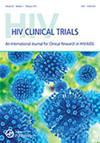Getting pregnant in HIV clinical trials: women’s choice and safety needs. The experience from the ANRS12169-2LADY and ANRS12286-MOBIDIP trials
Q2 Medicine
引用次数: 4
Abstract
Introduction: Pregnancy is an exclusion criteria in most clinical trials involving antiretroviral therapy (ART) and modern contraception methods are systematically proposed to women of childbearing age. Nevertheless pregnancies are often observed. Reproductive choices during clinical trials should be understood to adapt interventions to the level of risk for mother and baby safety. Our goal was to describe the reproductive behavior and pregnancy outcomes among HIV-infected women on second-line antiretroviral treatment enrolled in two clinical trials and to compare them with those of HIV-positive women in non-research settings. Methods: The number and outcomes of pregnancies were recorded among 281 non menopausal women enrolled in the ANRS 12169-2LADY and ANRS 12286-MOBIDIP clinical trials in Cameroon, Senegal and Burkina Faso. All participants had agreed to use a least one contraceptive method (barrier or non-barrier) which was provided for free during the study. Data were collected through revision of pregnancy notification forms and by data extraction from the study database, regularly updated and checked during the study. Results: Sixty-six women had 84 pregnancies between January 2010 and July 2015 resulting in a pregnancy rate of 8.0 per 100 women-years (WY) (95% CI 6.5–9.9) which is similar to the ones observed in cohort studies in Sub-Saharan Africa (varying from 2.5 to 9.4 pregnancies per 100 WY). Among 60 live births, 10 (16.6%) were born prematurely and 9 (15%) had a low birth weight. Sixteen miscarriages/stillbirths occurred (19.5%). This percentage is comparable to the one expected in the seronegative population which is reassuring for HIV-positive women considering pregnancy on ART. Only one minor birth defect was diagnosed. In univariate and multivariate analysis, miscarriages/stillbirths were not associated either with age, nadir of CD4 count, duration of ART, CD4 count, or viral load at the beginning of pregnancy. Conclusion: HIV-positive women participating in clinical trials conducted in Sub-Saharan Africa tend to get pregnant as often as seropositive women who received medical care in non-research settings. It is therefore essential to adopt a pragmatic approach by re-evaluating the relevance of the criteria for exclusion of pregnant women according to the risk associated with exposure and to seek more effective and innovating contraceptive strategies when using potentially teratogenic molecules.在艾滋病临床试验中怀孕:妇女的选择和安全需求。ANRS12169-2LADY和ANRS12286-MOBIDIP试验的经验
在大多数涉及抗逆转录病毒治疗(ART)的临床试验中,妊娠是一个排除标准,现代避孕方法被系统地推荐给育龄妇女。然而,怀孕是经常观察到的。应了解临床试验期间的生殖选择,以使干预措施适应母亲和婴儿安全的风险水平。我们的目的是描述两项临床试验中接受二线抗逆转录病毒治疗的艾滋病毒感染妇女的生殖行为和妊娠结局,并将其与非研究环境中艾滋病毒阳性妇女的生殖行为和妊娠结局进行比较。方法:记录在喀麦隆、塞内加尔和布基纳法索参加ANRS 12169-2LADY和ANRS 12286-MOBIDIP临床试验的281名非绝经期妇女的妊娠次数和结局。所有参与者都同意使用研究期间免费提供的至少一种避孕方法(屏障或非屏障)。通过修订妊娠通知表和从研究数据库中提取数据收集数据,并在研究期间定期更新和检查数据。结果:2010年1月至2015年7月期间,66名妇女怀孕84次,妊娠率为每100名妇女年(WY) 8.0次(95% CI 6.5-9.9),这与撒哈拉以南非洲队列研究中观察到的妊娠率相似(每100名妇女年怀孕2.5至9.4次)。在60例活产婴儿中,10例早产(16.6%),9例低出生体重(15%)。发生16例流产/死产(19.5%)。这一比例与血清阴性人群的预期比例相当,这对于考虑接受抗逆转录病毒治疗怀孕的艾滋病毒阳性妇女来说是令人放心的。只有一个轻微的先天缺陷被诊断出来。在单因素和多因素分析中,流产/死产与年龄、CD4计数最低点、抗逆转录病毒治疗持续时间、CD4计数或怀孕初期的病毒载量无关。结论:在撒哈拉以南非洲参加临床试验的艾滋病毒阳性妇女往往与在非研究环境中接受医疗护理的血清阳性妇女一样经常怀孕。因此,必须采取务实的做法,根据与接触有关的风险重新评估排除孕妇的标准的相关性,并在使用可能致畸的分子时寻求更有效和创新的避孕策略。
本文章由计算机程序翻译,如有差异,请以英文原文为准。
求助全文
约1分钟内获得全文
求助全文
来源期刊

HIV Clinical Trials
医学-传染病学
CiteScore
1.76
自引率
0.00%
发文量
0
审稿时长
>12 weeks
期刊介绍:
HIV Clinical Trials is devoted exclusively to presenting information on the latest developments in HIV/AIDS clinical research. This journal enables readers to obtain the most up-to-date, innovative research from around the world.
 求助内容:
求助内容: 应助结果提醒方式:
应助结果提醒方式:


